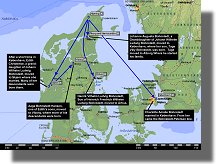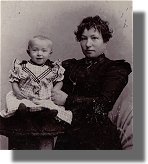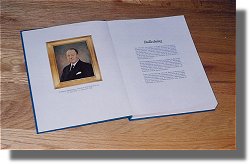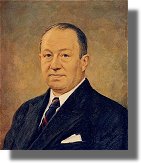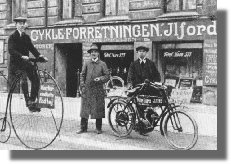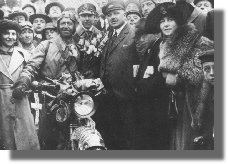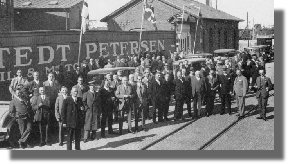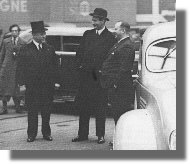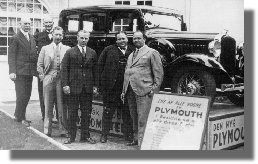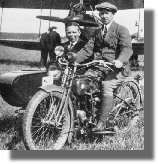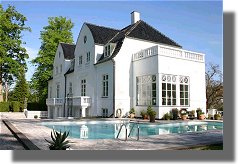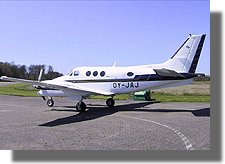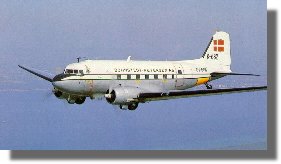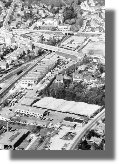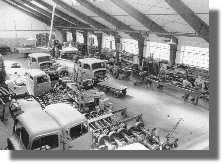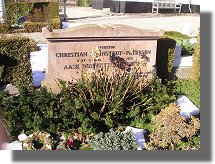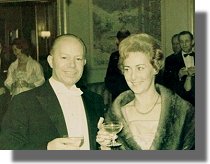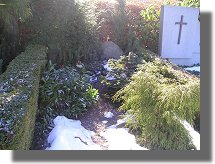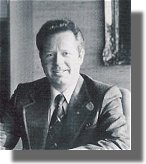BOHNSTEDT-PETERSEN HISTORY |
The Bohnstedt-Petersen Family and the Bohnstedt-Petersen A/S Firm Author Thomas Allen Bohnstedt, Los Angeles, USA - 2008 Charlotte Amalie Bohnstedt and Christian Bohnstedt-Petersen In 1892 Charlotte Amalie Bohnstedt, the sixth child of Johan Wilhelm Ludwig Bohnstedt and Johanne Augusta (Poulsen) Bohnstedt married Peder Christian Pedersen, a shoemaker from København (Copenhagen), Denmark. They settled in København, and they had two children that we know of; Christian Bohnstedt-Petersen, born in 1894, and a sister named Edith Charlotte Petersen, born five years later. 1. Charlotte Amalie Bohnstedt married Peder Christian Pedersen in København and started the Bohnstedt-Petersen family line there Christian founded the Bohnstedt-Petersen branch of the Bohnstedt family in Denmark. He also founded Bohnstedt-Petersen A/S, an automobile and aircraft manufacturing and distributing company. As a result, Bohnstedt-Petersen A/S, and by extension, the Bohnstedt name, became well known throughout Denmark. 3. 75 År Til Lands & I Luften Much of what follows in this section is derived from a combination of testimony from Peter Bohnstedt-Petersen (Christian's younger son), Frank Bohnstedt-Petersen (Peter's nephew) and a book called 75 År Til Lands & I Luften, written in Danish, about Christian Bohnstedt-Petersen and the company he founded. Portions of it were translated by several people, including Mette Bohnstedt, and Corky Gordon (a personal friend). The most recent translation was done by Thorkil Svendsen, a great-grandson of Louise Henriette Bohnstedt. Thorkil did a very fine job of reading through the entire book and summarizing the entire Bohnstedt-Petersen story in just a few pages. Finally, a lot of information about the family and company was contributed by Frank Bohnstedt-Petersen.
Beginning with Bicycles Christian Bohnstedt-Petersen had only a secondary school education, and he left school when he was only thirteen years old. But with a lot of hard work and energy, a strong will-power, an unusual business talent, foresight, and good luck, he managed to build up a flourishing import and trading business. After leaving school he got an apprenticeship with his father who was making and selling motorbikes, and worked with him during 1908 - 1910. Christian wanted to see the world, and in 1910 he went to sea. When he came home again in the Summer of 1911 Christian found that his father had died some months earlier.
5. Christian Bohnstedt-Petersen in the doorway of his father's shop. Note that the sign on the side of the building bears his father's name; "P.C. Petersen" (Peder Christian Petersen) That Summer Christian opened his first business with the money he had earned while sailing; a bicycle shop called "Ilford" at Nørre Alle 9 in København. He was only 17 when he began the business, and since it was not legal to operate a business under the age of 21, he operated it under his parent's names. Although he had begun by making and repairing bicycles he had also been building motorbikes. By 1913 he realized that motorbikes had become the biggest part of his business, and in the following years abandoned the bicycle business. In 1913 he also found that there was a need for motorcycle sidecars, and so with a crew of eight men he began producing sidecars.
From Bicycles to Motorcycles Christian believed that there were big possibilities in motorizing Denmark, and in 1916 he traveled to America to learn more about the industry. He stayed for a short time in Milwaukee, Wisconsin and worked for Harley-Davidson Company. While there he acquired an agency, that is, the right to manufacture and sell the company's products elsewhere, under license. He returned to Denmark in 1917 bringing with him two samples, an automobile called a "Metz", and a motorbike called a "Military" in the ship. Unfortunately, the First World War was causing petroleum shortages, which was causing business to go badly. He had been in a partnership with a man named Lillesøe, but the business problems caused some disagreements, and Christian decided to start a business of his own. Christian also became very enthusiastic about Motor Sports at his young age, and despite his business schedule he participated in several cross-country motorcycle races in Denmark and Europe. He later sponsored drivers in some races.
7. Christian Bohnstedt-Petersen after the Paris-København Grand Prix race, 1921 In a Grand Prix race from Paris to København, held in August 26-28, 1921, Christian crashed his Reading Standard motorcycle, severely injuring his leg. He got back on his motorcycle with his injured leg and continued. Just outside of Kassel, Germany, Christian suffered another serious accident and an injury to the same leg, this time requiring medical attention. Christian was admitted to the hospital in Kassel and was supposed to remain for ten days. Christian did not stay for ten hours. He left the hospital, got back on his motorcycle, and continued on to København, finishing third in the race. After the end of the First World War Christian approached another man named Friis-Hansen, who had the license to import Reading Standard Motorbikes from the U.S., and an agreement was reached in which Christian would sell Reading Standard motorbikes for Friis-Hansen. Later, Christian entered into another partnership with N.T.Beier and the firm "Bohnstedt and Beier" was created. But again business went badly, this time because of a falling dollar rate (this may have been about the time of the great depression), and the firm had to sell motorbikes at a loss of up to 1000 Kroner each. Expanding into Automobiles Beier left the partnership, and Christian was again on his own. This time he began selling cars. The first car he imported was an "Overland", and later a Chrysler. Business improved, and the sales of automobiles and motorbikes continued to increase. In 1930 he sold 1551 cars and motorbikes in Denmark.
Expanding into Automobiles Beier left the partnership, and Christian was again on his own. This time he began selling cars. The first car he imported was an "Overland", and later a Chrysler. Business improved, and the sales of automobiles and motorbikes continued to increase. In 1930 he sold 1551 cars and motorbikes in Denmark.
8. Bohnstedt-Petersen automobile plant, København. Christian Bohnstedt-Petersen is second from the right in the front row In 1920 Christian had decided that he would not only be an importer of automobiles and motorbikes, but that he would also assemble cars. In 1930 he opened an assembly plant where he could produce 2500 cars per year and in a partnership agreement with Plymouth he began assembling automobiles with the Plymouth brand. In 1934 he got an agreement with Daimler-Benz to be their agent in Denmark and from 1935 to 1936 the Bohnstedt-Petersen firm was the first outside of Germany to assemble Mercedes-Benz automobiles. At that same time Christian also acquired the license to import Renault cars from France. 10. Bohnstedt-Petersen offices and plant in København During the 1930's Bohnstedt-Petersen also assembled the DKW F-8 automobile from the Auto Union Werke in Germany, another major success for the Bohnstedt-Petersen firm. The DKW F-8's affordable price made the car popular and provided jobs to many Danish automotive workers. The DKW was unusual in that it's body was made largely out of wood. The import of motorcycles from the U.S., Britain and Germany also made a substantial contribution to the Bohnstedt-Petersen in the years just prior to the Second World War.
The Air Age In 1903, at a place called Kitty Hawk in North Carolina, in the United States. Orville Wright made what is generally recognized as the first, sustained, powered, controlled, heavier-than-air flight. Five years later the United States Army Signal Corps contracted with Orville, and his brother, Wilbur, to produce a plane that could fly for 10 minutes at a speed of 64 km/h (40 mph). Thus began the Air Age. But, European developments in aviation quickly overtook American aviation progress. This was due mainly to the First World War in Europe. Britain, Germany, Russia and France all pushed aviation progress out of military necessity, while America often followed European trends in aircraft development. The U.S. Army and U.S. Navy often purchased airplanes from European builders. 12. Christian Bohnstedt-Petersen on motorcycle, 1920 Christian Bohnstedt-Petersen was one of those whose interest in machines was not confined to the ground. He took flight instruction from the Neilsen and Winther flight school at Kløvermark, and received his flying certificate on November 15, 1918. Christian Bohnstedt's most extensive involvement in aviation later proved to be not in flying, but in building aircraft. In 1937, Jack Hedegaard, a Danish engineer returned from the U.S. with license from the Taylor Aircraft Company to build the Taylor Cub aircraft in Scandinavia. At about the same time, Mr. Taylor's business partner, Mr. Piper, took over Mr. Taylor's share of the business and renamed the company the "Piper Aircraft Company", and the machine, the "Piper Cub". Hedegaard ran into problems with capital, and Christian signed a contact with the Piper Aircraft Company to take over the agency in Scandinavia.
14. Hegnsholt Estate as it looks today (recent photo) Christian constructed a hanger on the grounds of his property named "Hegnsholt" in Grønholt near Fredensborg and had a landing strip created in the grass field there. The firm managed to produce 32 Cub airplanes before the Second World War started, with Christian's son, Henry Bohnstedt-Petersen, handling the aircraft sales.
16. Bohnstedt-Petersen C-47 Aviation remained a family interest. Christian's son, Peter, was also interested in flying, and he established a flying school. Having a family-owned flying school enabled Henry's son, Finn to gain his pilot's license and flying skills which he later used as an airline pilot for Scandinavian Airlines System (SAS) where he flew McDonnell-Douglas, Boeing and Airbus airliners. Henry's other son, Frank, also gained his own private pilot's license at the flying school.
18. The C-130 transport was among the types flown by Major Michael Bohnstedt-Petersen as a pilot with the Royal Danish Air Force The aviation tradition in the Bohnstedt-Petersen family continued into the next generation; Finn's son Michael joined the Royal Danish Air Force and, after completing officer training, entered navigator training and flight training. He was promoted to Captain in 1998, and promoted again in 2004 to the rank of Major. Major Michael Bohnstedt-Petersen has flown C-130's and military versions of Gulfstream III aircraft.
The Second World War The Second World War again brought business difficulties to the Bohnstedt-Petersen Firm. As soon as the war started it was no longer allowed to drive cars or motorbikes in Denmark, probably because of fuel shortages. Instead of producing cars and motorbikes, the firm switched to the production of electric generators and other devices. After the German occupation of Denmark the Germans tried to persuade Christian to convert the factory to the needs of the German armaments industry but Christian didn't want to do it. The Germans confiscated the factory anyway and began making components for German submarines and airplanes. During this period Christian seldom visited the factory, and drove only American cars such as Chrysler and Desoto. In 1944 Danish partisans succeeded in destroying much of what had been produced at the factory as it was on trains leaving for Germany, and in June of that year the partisans sabotaged the factory. Frank's father, Henry, told him that one day Danish freedom fighters stormed the factory with machine guns shouting to everybody to get out immediately. Explosives were then detonated and the factory destroyed. Christian was even arrested after the war and put on trial for collaborating with the enemy. It took several years, said Frank, and the case went all the way up to the Danish Supreme Court, but about 1952 Christian was eventually found not guilty of the charges and acquitted. Apparently the people from Daimler-Benz who had helped the German government appropriate the factory came to København to testify on Christian's behalf, stating that he had been forced to turn over the factory against his will. According to Frank Bohnstedt-Petersen his grandfather, Christian, lost all of his British and American import arrangements after the war. The perception among the public was that he had been a collaborator with the Germans, a belief which may have been reinforced by the fact that the Bohnstedt-Petersen company had such a close relationship with Daimler-Benz in the years prior to the war. But the Bohnstedt-Petersen company did manage to keep the Mercedes agency after the war. 19-20. Bohnstedt-Petersen manufacturing plant in Hillerød During the war Christian had hidden enough parts and material to assemble 400 cars. After the end of the war there was a demand for cars in Denmark, and Christian started up manufacturing again by producing 400 vehicles. The factory had been destroyed, so Christian constructed a new plant in Hillerød, near København about 1948-1949. The first vehicle to come off the assembly line after the war was a Mercedes L3500 truck on July 3, 1954. From that time Bohnstedt-Petersen A/S built mostly trucks. From 1949 the production in Germany of Mercedes-Benz passenger cars also slowly regained momentum after rebuilding the Mercedes-Benz factories that had been severely damaged during the war. In the new Bohnstedt-Petersen plant in Hillerød the assembly of the Mercedes model 180 passenger car became part of the daily production, which came to 6 trucks and 6 passenger cars per day. DKW from Auto Union was again introduced to the Danish market by Bohnstedt-Petersen but the car never regained its former success in sales. Until 1956-1957 motorcycles played a vital part of the business, especially the DKW motorcycle. For a few years in the 1950's Hudson and Desoto cars from America were a smaller part the company’s businesses.
The Company Changes Hands Christian died in 1956 at age 62 and his son Henry took over management of the firm and in 1959 he took over management of the Bohnstedt-Petersen daughter company Autoropa A/S. About 1960-1961 Peter was appointed to the company's board of directors. A few years later Christian's younger son Peter reached the age of 20, and Peter's mother bought out Henry in a deal that was, according to Henry's son, Frank, a reasonable deal. 21. Three generations of Bohnstedt-Petersen men; L-R: Henry (raincoat), Christian (black hat), Peter (in the sport coat with the Mercedes emblem), and Frank (the young boy behind Peter, standing next to Christian) Under Peter's direction the company began to expand throughout Denmark. The late 1950's and the 1960's were a very busy time for Bohnstedt-Petersen A/S, producing about 2000 cars and 2000 trucks per year, but in 1966 the company stopped doing any assembly work. Apparently it was becoming unprofitable to assemble cars and trucks in Denmark, so the company began to rely exclusively on importing fully assembled vehicles.
23. Henry Bohnstedt-Petersen with his wife Betty Peter led the company with great skills and energy during the next couple of decades. Frank Bohnstedt-Petersen states that at it's peak the company had the sole import agency for Mercedes Benz cars, and had about 35 dealerships throughout Denmark. During the last years of this period Bohnstedt-Petersen A/S also imported Mitsubishi automobiles, although, according to Frank, Mitsubishi actually did not constitute a large segment of the Bohnstedt-Petersen company's imports. By the late 1980's the company was doing about 300 million U.S. dollars (about 2 billion Danish kroner) in annual business sales. 25. Peter Bohnstedt-Petersen, circa 1981 By the early 1990s market conditions had changed and Bohnstedt-Petersen's two main partners, Mercedes and Mitsubishi, decided they wanted to exclusively control the imports of their automobiles into Denmark. They canceled their contracts with the Bohnstedt-Petersen company and set up their own import organizations. With no exclusive import contracts left with Mercedes and Mitsubishi, indeed, with no import capability at all, there was essentially no business left for Bohnstedt-Petersen A/S, and no purpose for the numerous dealership facilities owned by the company. The only alternative was to sell the facilities to Mercedes and Mitsubishi, who took much of the Bohnstedt-Petersen staff with them. 27. Grave of Peter Bohnstedt-Petersen, Grønholt Church Cemetery For Bohnstedt-Petersen A/S 1991 was the end. Peter died eleven years later in 2002, and was buried in the Grønholt Church Cemetery next to his father, Christian Bohnstedt-Petersen. The accomplishments of the Bohnstedt-Petersen family and the success of the Bohnstedt-Petersen A/S company for nearly a century have added greatly to the notoriety of the Bohnstedt name in Denmark. The Bohnstedt-Petersen line continues in Denmark through four grandchildren of Christian Bohnstedt-Petersen. These are Henry’s two sons; Christian Frank Bohnstedt-Petersen and Finn Henry Bohnstedt-Petersen, and Peter’s two children; Bettina Bohnstedt-Petersen and Christian Bohnstedt-Petersen. The Bohnstedt-Petersen name is then carried forward through Frank’s son Lars, an advertising and marketing consultant, Finn’s son Michael, a major in the Danish Air Force, and Finn's daughter Maria, who is majoring in medical prosthetics studies at University in Jönköping, Sweden. Thomas Allen Bohnstedt - Los Angeles - 2008 |
